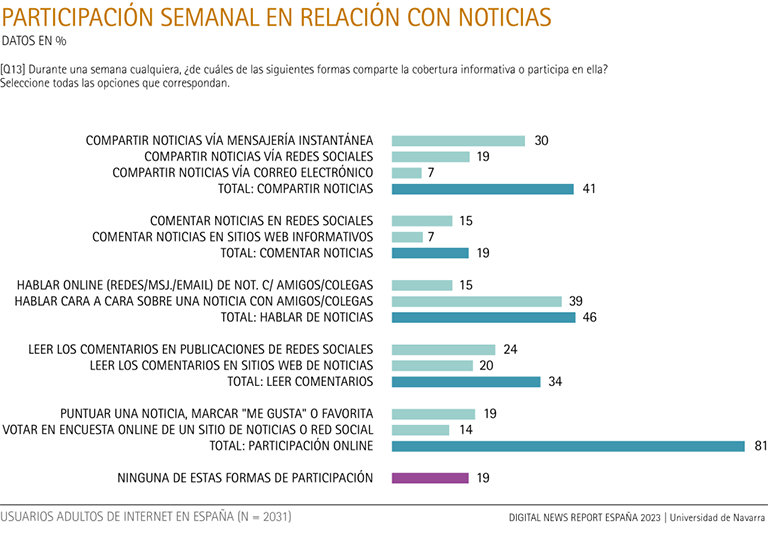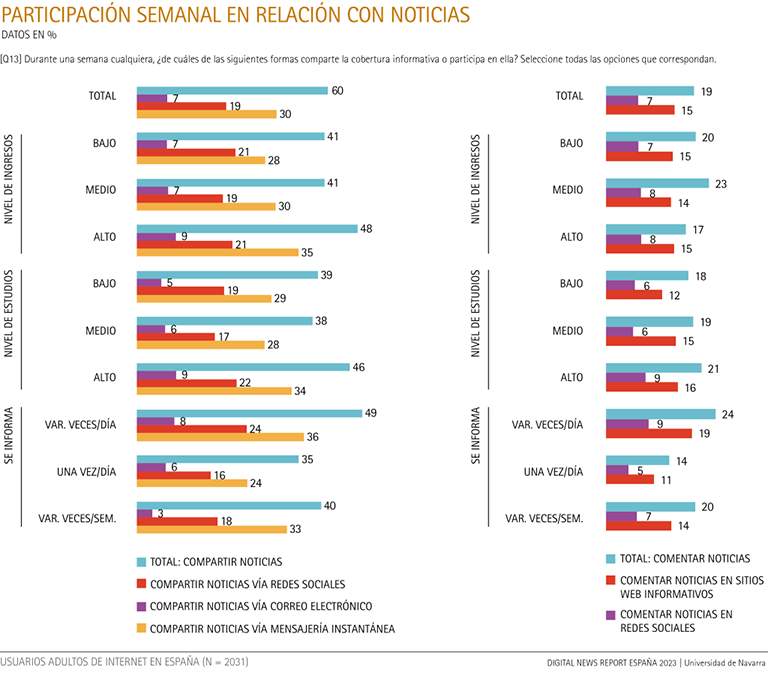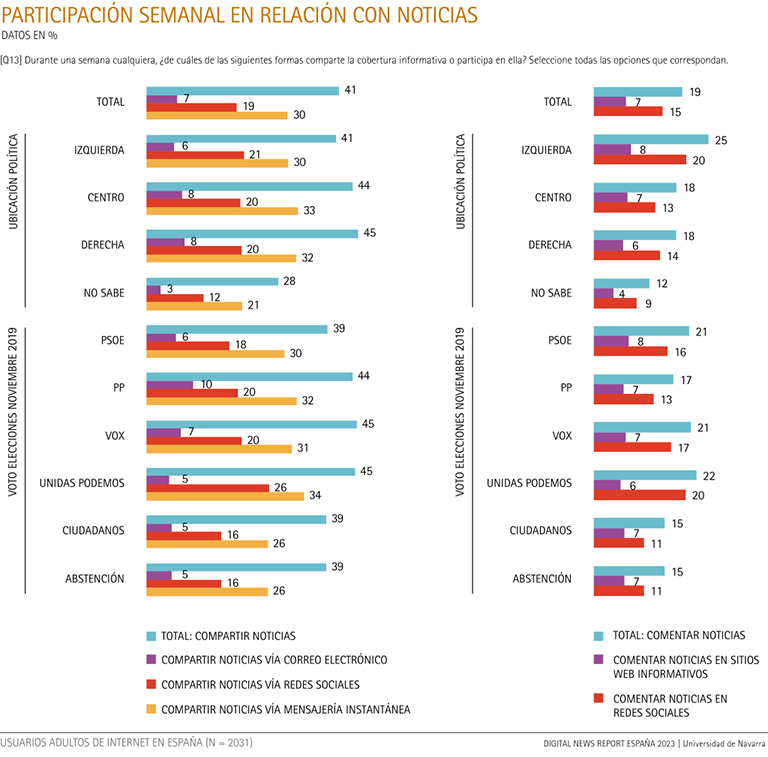-
For sharing news, instant messaging (30%) outperforms social networks (19%) and email (7%), and for commenting, networks (15%) are twice as popular as the media (7%).
-
Forty-six percent of Spaniards talk about news with friends and acquaintances: four out of ten (39%) do so face-to-face, and 15% via the Internet.
-
Spain outperforms average globally in sharing news and talking about it with acquaintances, but lags behind in commenting and reading comments from other users.
-
Twice as many do not talk about politics (26%) over the Internet than those who do not do so in person (13%), and just one in five do so carelessly.
Eight out of ten adults in Spain with an internet connection (81%) participate in some way around news over the course of a standard week, mainly by sharing news (41%), but also by commenting on it (19%), equally by age and between men and women; these eight out of ten also include those who read comments from others (34%), either on social networks (24%) or on news sites (20%).

However, there are quite a few modes of participation that have a more marked age profile . group Talking online with friends and colleagues about news (15% in the adult population as a whole) is much more popular in the 18-24 age group (27%), followed by the 25-34 age group (21%), and the 35-44 age group (17%); the older age groups of 45-54 (13%) and 55+ (11%) are below average . Voting in online polls on current affairs is more fashionable in the 18-24 age group: 21% do so, compared to the overall figure of 14% of Spanish online adults.

In particular, more popular among older users are rating, rating or "liking" news items (23% of those aged 55 and over, compared to 19% of all adults), commenting on news on social networks (18% of those aged 54 and over, three points more than the total) and sharing news by email (8% in this age group of older people group ). Users aged 45 and older also read much more comments on media news (22%) than adults up to 44 (17%).

People with higher income levels and programs of study share news more, both on social networks and via instant messaging, as do those who get information several times a day. The same is true for talking about the news with other people they know, both in person and especially face-to-face, as well as reading comments. On the other hand, the internship of commenting on the news is more evenly matched, with those with a medium income level standing out, as well as those who inform themselves more frequently. At final, for the set of participation modalities, the frequency with which users are informed is a very decisive factor, and nine out of ten users who are informed several times a day also interact with the information in one of the ways described above.

We now focus on participation in relation to the political location of users on the left-right axis. The main differences are systematically found among those who do position themselves, compared to those who say they do not know where to place themselves on this axis. Thus, 85% of those who place themselves in the political center, 83% of those on the right and 79% of those on the left participate weekly in relation to the news, compared to only 68% of those who "do not know" where they place themselves politically.
Specifically, 45% of right-wingers say they share news, 44% of centrists and 41% of leftists, compared to 28% who share news without knowing how to define themselves politically. On the other hand, when it comes to commenting on news, leftists significantly exceed, by six percentage points, the average (19%), close to that of center or right-wing respondents (18%), and those who do not identify themselves politically fall to just 12%. In talking about news on the Internet or in person with friends and acquaintances, those in the center stand out, and although those who do not define themselves fall slightly with respect to average, they do so less than in other categories. This is the case, for example, of reading comments: internship is equally widespread among users on the left and in the center (36%), with those on the right (33%) one point below average, and those who are politically undefined present a much lower figure, 24%. Finally, right-wingers (20%) are much more likely to vote in Internet polls than centrists (14%), left-wingers (13%) or the politically undefined (10%).
Finally, we move on to look at the affiliation of the respondents to political parties. In general, those who remember having voted in the last general elections prior to the survey (November 2019) for the PP (85%), Ciudadanos (84%) or Vox (82%) participate more, while those who abstained in that electoral quotation (80%) and those who voted for the parties that formed the government that came out of those elections, PSOE (79%) and Unidas Podemos (77%), participate less.
Thus, in some cases, those who gave their confidence in the 2019 general elections to some party participate to the same extent as those who abstained. First, PSOE voters shared news the same as abstainers (39%, two points below the average), compared to 44-45% of voters of the other four main parties.
In the case of commenting on news, those who are at the same level as abstentionists (15%) are former Ciudadanos voters, while those who remember having voted for the PP reach 17% in this action of commenting, still two points below average; PSOE and Vox voters (21%) and those of Unidas Podemos (22%) comment more, especially in social networks. Also those who voted for UP in the general elections (slightly more than three years before the survey) read the comments of others in a higher proportion than voters of other parties: 43% those of UP, 38% those of Cs, 36% those of PSOE, and at average (34%) those of PP; below, abstentionists (30%) and Vox (29%).
In contrast, former Ciudadanos voters in the 2019 general election are the ones who most say they have talked about news with friends and acquaintances, either face-to-face or also directly through the Internet (60%); they are twelve points more than those who voted for the PP (48%), and former voters of Unidas Podemos stand at average (46%); below, PSOE voters (45%) and Vox (41%) in that 10-N.
Once again this year, the Spanish audience, among the most participative
The 81% achieved by the sum of all types of participation in Spain is three percentage points higher than average of 46 countries, in which Italy is located (78%), and at the same level as Portugal (81%). The United Kingdom and Germany are positioned at 62%, and France at 71%; slightly above the Spanish rate are some Eastern European countries. In the United States, 70% of users participate in some way. fees Latin America shows higher participation rates: 79% in Argentina, 83% in Chile and Brazil, 86% in Mexico and Colombia, and 89% in Peru.
Spain does not exceed average in all modalities: the Spanish market does score 41% in sharing news, compared to 35% for the average of 46 markets, and also 46% in talking about news, when the global figure is 40%, but only 34% of Spanish adults read comments from other users on news websites and external platforms, while the global figure is 41%, and equally lower than the average of all countries (22%) is the proportion of Spanish adults who comment on news, either on websites and media apps or on social networks (19%).
In fact, Spain is the second European country surveyed after Portugal (42%) where most news is shared, and is also (19%) one point behind the neighboring country (20%) in commenting on news, an activity in which both countries are only surpassed in Europe by some Eastern European countries. On the other hand, in Nordic countries such as Sweden (50%) or Norway (49%) people talk more about news than in Spain, and reading other people's comments is more popular in most markets other than Spain.
More positive than negative experiences when participating on the Internet, but more careful when talking about politics than face to face
This year, survey also asked users about their feelings when interacting with information on the Internet. Positive experiences of engaging with news on websites and media apps and social networks (30%) quadruple those that are negative (7%), although for the majority they are neither (49%).
Men have more positive (33%) and negative (9%) experiences, as opposed to women (28% and 6%, respectively). There are no major distinctions in positive experiences by age (37% recall more positive experiences in the 18-24 years age group), but negative experiences are twice as frequent among adults under 35 years of age (12%) than those aged 35 years and older (6%).
In Spain there are slightly fewer positive experiences than the global average (30% compared to 33% of the 46 countries), but negative experiences in Spain are among the lowest fees in the world (7% of this market is six points lower than the overall figure for all the markets surveyed), at levels comparable to those of the Latin American countries.
Twice as many users do not discuss politics (26%) online (e.g., via social networks or messaging services) as those who do not do so in person (13%). The Spanish adult population with Internet access is just as careful when discussing politics online (50%) as in person (49%), but, on the other hand, 20% say they are not careful when discussing politics online ( topic ), compared to 34% who are careless when doing so in person.
Compared to the 46-country average , those who are careful in Spain are four points less than the whole (54% globally), and those who are not careful are four points more (16% in the part of the world surveyed). The majority of audiences in neighboring Western European countries are less careful, but Portugal (57%) and Ireland (51%) exceed the 50% threshold set by Spain; so do Poland (58%), Austria (57%), Greece or Croatia (56%), and in Latin America these fees rise to 70% in Peru, 64% in Brazil, 58% in Mexico, 57% in Chile or 54% in Argentina.